
* The Gloster Meteor was the first operational British jet fighter, and the only Allied jet fighter to see combat in World War II. The Meteor served in the postwar period with many different air services and in many different roles. This document outlines the history of the Meteor.
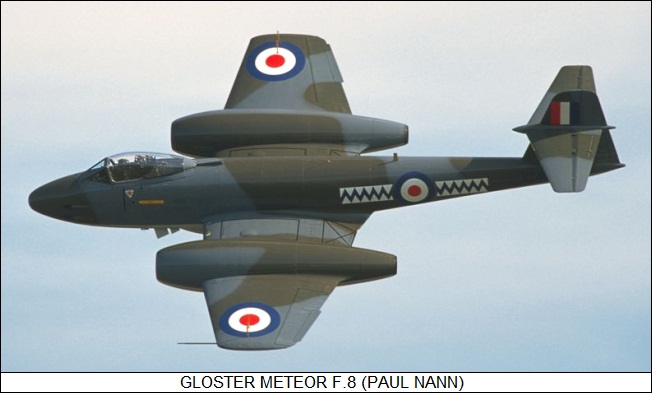
* The early story of the Gloster Meteor is intertwined with British efforts to develop turbojet engines. In 1929, a young British Royal Air Force (RAF) flight officer named Frank Whittle came up with ideas for building an aircraft engine based on the gas turbine. Other researchers had played with the concept, but Whittle was the first to have the engineering and aeronautical skills to do something useful with it.
Since all earlier attempts to develop an aircraft engine based on the gas turbine engine had failed, and Whittle's notions were so new and unusual, he was generally dismissed by government and industry authorities. However, Whittle was stubborn enough to apply for a patent on his ideas in 1930, and continued to promote his engine concepts, with a remarkably lenient RAF giving him time and opportunity to pursue the matter.
In 1936, Whittle set up a small firm named Power Jets LTD to pursue his ideas, and was soon applying for new patents. One was for a "bench-test" gas-turbine engine designated the "Whittle Unit (WU)". Whittle began tests of the WU in 1937. The tests were successful -- if sometimes extremely frightening, with the engine having a nasty tendency to go into violent runaway. Fortunately Whittle was not killed or maimed, and managed to get the WU working well enough that by 1938 the British Air Ministry began to provide him with moderate funding to continue his work.
In June 1939, with the WU working in a reliable and impressive fashion, the Air Ministry ordered a flight-worthy engine, the "W.1", from Power Jets. In September 1939, the Air Ministry also ordered that Gloster design an aircraft, the "E.28/39", to test-fly the engine. In the meantime, Whittle was hearing rumors that the Germans were also working on "turbojet" engines, as they came to be known.
* Things were still not smooth sailing for Whittle. The Air Ministry was interested in his engine, but it wasn't the highest priority, and by September Britain was in a war that the country was poorly prepared to fight. In fact, by the summer and fall of 1940, Britain was struggling against German Luftwaffe air fleets that pounded the island, with an invasion seeming imminent.
Despite the disruption caused by the Battle of Britain, work on turbojet engines and aircraft continued at a low level. In fact, in 1940 the Air Ministry issued a request, designated "F.9/40", for an operational turbojet-powered fighter. Given that Whittle's W.1 and its possible derivatives appeared significantly underpowered, Gloster's chief engineer George Carter proposed a twin-engine aircraft with the company designation "G.41" for the specification.
The proposal was approved in November 1940, with a batch of twelve prototypes ordered on 7 February 1941. The G.41 was named "Thunderbolt" in September 1941, but in early 1942 it became apparent that the name would cause confusion with the new American Republic P-47 Thunderbolt, and so was changed to "Meteor". Some sources also claim that it was called "Rampage" during trials, though this may have been a cover name used for security purposes.
* The first of two experimental E.28/39 test aircraft, which had the company designation of "G.40" and were known informally as the "Gloster Whittle", began taxi trials with a non-airworthy W.1X engine on 8 April 1941, with Whittle himself performing some of the tests, and Flight Lieutenant P.E.G. "Gerry" Sayer, Gloster's chief test pilot, performing a few "hops" off the runway that same day. After the aircraft was refitted with a proper W.1 engine, Sayer performed the first real flight in the aircraft on 15 May 1940, with everything going smoothly, and Sayer having little but good to say about the experience.
The second G.40 did not fly until March 1943. It would be lost due to a flight malfunction four months later, with the pilot baling out successfully. The first would eventually end up as a museum piece.
The G.40 was a simple all-metal "flying stovepipe" design, with a low-mounted straight wing and retractable tricycle landing gear. It was powered by a single Whittle W.1 engine, providing 3.78 kN (385 kgp / 850 lbf) thrust. It had a wingspan of 8.84 meters (29 feet), a length of 7.74 meters (25 feet 4 inches), a maximum loaded weight of 1,678 kilograms (3,700 pounds), and a modest top speed of 544 KPH (338 MPH).
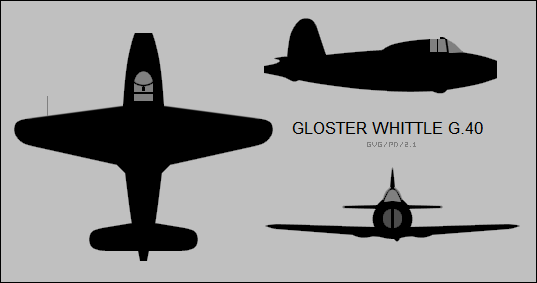
Well, it was a beginning. Power Jets continued to refine the engine design to create the "W.2B" series turbojets, which incorporated successive refinements until they provided almost 11.0 kN (1,130 kgp / 2,500 lbf) thrust. The different engine subvariants were all the same diameter and could be flight-tested in the G.40 aircraft, which ultimately obtained a top speed of at least 750 KPH (466 MPH) -- as fast or faster than the speediest contemporary piston-engine aircraft.
BACK_TO_TOP* Despite Whittle's success, development of the operational G.41 fighter was slow. Power Jets was not in a position to mass-produce the Whittle engine, and trying to find another firm with adequate resources led to a two-year delay in production. As a result, progress of the G.41 project ended up tracking the somewhat convoluted path of early British turbojet development.
By October 1940, the Air Ministry was interested enough in the Whittle engine to arrange for production of the W.2B by Rover. Unfortunately, the term "mis-arranged" is probably more appropriate, since Power Jets and Rover worked at all times at cross purposes, with the confusion aggravated by contrary instructions from the British Ministry of Production. The jet engine development effort slowly strangled on its own red tape until 1942, when Rolls-Royce's Ernest Hives took S.B. Wilks of Rover out to lunch and, as the story has it, asked Wilks: "Give us this jet job, and we'll give you our tank-engine factory in Nottingham."
Rolls-Royce wanted the jet engine and knew what they wanted to do with it, and indeed, beyond the end of the millennium, still does. In fact, the company's own engineering staff had been working on jet propulsion since 1939, and in making the swap Rover was giving away something they didn't really want, while Rolls-Royce was obtaining a treasure.
A W.2B engine, plugged into the tail of a Vickers Wellington bomber, was test-flown that November, and after further improvements was test-flown in the second G.40 Gloster Whittle in March 1943. The W.2B was providing 7.11 kN (725 kgp / 1,600 lbf) thrust by this time. Rolls-Royce worked with Whittle to finally get an uprated version of the W.2B engine in production as the "Welland I".
* The Whittle WU, W.1, and W.2B were all "centrifugal-flow" engines, which used a turbine similar to a pump impeller to force air into a set of combustion chambers or "combustors" ringed around the engine core. The flow of air went through the combustors from back to front, with such a "reverse flow" arrangement reducing the length of the engine. These engines had only the broadest resemblance to a modern military turbojet engine, but the same design concepts would not be out of place in a modern helicopter turboshaft engine.
Rolls-Royce then reworked the Whittle design to feature straight-through air flow through the combustors and better fuel and oil systems, resulting in the "Derwent I", providing 8.83 kN (900 kgp / 2,000 lbf) thrust. The Derwent was refined in various versions up to the Mark IV, which provided 10.8 kN (1,100 kgp / 2,450 lbf) thrust.
* Stanley Hooker, who had been in charge of the Rolls-Royce design team that refined the Derwent, visited the US in the spring of 1944 and found that the General Electric company was developing two turbojet engines with thrust ratings of 17.6 kN (1,800 kgp / 4,000 lbf) or higher. Hooker, realizing that the British had been thinking small, went back to Britain and initiated a fast-track project to build a new, much more powerful centrifugal-flow engine. The result was the "RB.41 Nene", which was first bench-tested in October 1944 and provided 22.3 kN (2,270 kgp / 5,000 lbf) thrust. The Nene was the world's most powerful engine at the time, and it was also simple, cheap, and reliable. The Nene was manufactured in large numbers, with versions made in Canada, Australia, France, the US, and the USSR.
The Nene was such a good engine that Rolls-Royce decided to build a scaled-down version, which was designated the "Derwent 5", though it had little direct relationship to earlier Derwent marks. The Derwent 5 was first bench-tested in June 1945, with the test engine providing 11.8 kN (1,200 kgp / 2,650 lbf) thrust.
* In the meantime, since early 1941 de Havilland had been working on their own centrifugal-flow turbojet engine -- derived from earlier Whittle patents, not the W.1 design. The result was the de Havilland "Halford H.1", which was first bench-tested in April 1942. By late 1943, the H.1 had been refined into the "Goblin" engine, which provided 10.2 kN (1,040 kgp / 2,300 lbf) thrust and would power the de Havilland Vampire fighter.
* British jet engine development was following yet another parallel track at the time. As far back as 1939, Metropolitan-Vickers ("MetroVic"), a Manchester firm that specialized in steam turbines, was working on what would become the first British "axial-flow" turbojet engine, a design that was very different from the centrifugal-flow engines being developed by Whittle and others. Such axial-flow engines featured sets or "stages" of fan blades arranged around a central axle, compressing air into a combustion chamber, which was followed by another set of fan blades that kept the axle spinning. The axial-flow turbojet would prove to be the way of the future for high-speed combat aircraft, though as noted the centrifugal-flow engine would become the basis for modern helicopter turboshaft engines.
The initial MetroVic engine, the "F.2", was first bench-tested in December 1941, and was producing 8 kN (815 kgp / 1,800 lbf) thrust by November 1942. The MetroVic designs eventually led to the "F.9 Sapphire", which was passed on to Armstrong-Whitworth in 1948 and was one of the more prominent jet engines of the 1950s.
BACK_TO_TOP* Only eight of the twelve G.41 Meteor prototypes were completed. They featured a confusing variety of engine fits, reflecting the zigs and zags of British engine development. The initial engine fit was specified as Rover W.2B engines, with the first and fourth prototypes completed with such powerplants. However, after performing taxi tests and short hops with the first G.41 prototype in July 1942, Gerry Sayer said the thing was simply too underpowered to fly safely, and as discussed, the Rover turbojet engine development effort was dying of its own bureaucracy.
The first Meteor to actually fly took to the air on 5 March 1943, with Michael Daunt at the controls. It was the fifth in the prototype manufacturing sequence and was fitted with de Havilland Halford H.1 turbojets, the ancestor of the Goblin. This particular engine fit led to the sixth prototype, which flew on 12 July 1945 and featured full-development de Havilland Goblin engines. The sixth prototype was to lead to a "Meteor Mark II (G-41B)" series, but de Havilland wanted to reserve Goblin production for their Vampire fighter; the Meteor Mark II didn't enter production, and operational Meteors would never feature Goblin engines.
The third prototype featured another unusual engine fit, being powered by MetroVic F.2 axial-flow engines in oversized nacelles. It flew in November 1943, but although other axial-flow engines would be tested on later versions of the Meteor, all operational Meteors would be fitted with centrifugal-flow engines. The other prototypes were fitted with variations on the W.2B engine, except for the eighth, which was fitted with Rolls-Royce Derwent I engines. This aircraft flew on 18 April 1944, and pointed the way to operational Meteor marks.
* There was uncertainty over production of the Meteor for some time. The jet engines available at the time were clearly "fuel hogs" and so the Meteor necessarily had limited range, making it suitable only as an interceptor. Since the bombers of the German Luftwaffe were no longer a real threat to the British Isles, and to the extent that they were they could be dealt with by current fighters, there was no immediate reason to disrupt critical production of existing aircraft to field the Meteor.
However, from mid-1943 intelligence reports of new German jet aircraft and missiles had indicated that it might be wise to keep up with enemy technology, a realization that led to the first production Meteor, the "Mark I (G-41A)", which was basically used for operational evaluation. 20 were built by Gloster, with the first flying on 12 January 1944. They were fitted with Rolls-Royce W.2B / Welland I engines with 7.55 kN (770 kgp / 1,700 lbf) thrust each. The Meteor I had a "clear-view" canopy instead of the heavy framed canopy of the prototypes.
The Meteor I was fitted with four 20-millimeter Hispano Mark III cannon -- though six had been specified in the original G.41 requirement, and in fact one of the prototypes had featured six cannon. The problem with six cannons was that one pair of cannon was so mechanically inaccessible that, under some circumstances, ground crews would have had to remove them while they were still loaded. That was a dangerously accident-prone arrangement; any experienced military person knows that if stupid accidents can happen, they will, and so those two cannon were deleted, leaving two cannon mounted on either side of the nose. The deletion of the two cannon led to balance problems that required nose ballast, a fix that would get worse before it got better.
The Meteor I was an all-metal aircraft of conventional construction, with low-mounted straight wings with two spars, turbojets mid-mounted in the wings, and a high-mounted tailplane to keep it out of the way of the jet exhaust. It had "fence"-style air brakes above and below the wings inboard of the engines to keep the aircraft controllable in a high-speed dive.
The Meteor was designed in a "modular" fashion, a consequence of the fact that it had been originally ordered during the Battle of Britain, when planners had considered the need for "dispersed production" -- different factories building different subassemblies of the aircraft, for final assembly at a central location. This basic scheme was retained in later versions, making the Meteor easy to transport, repair, and salvage.
The Meteor had tricycle landing gear, which were shorter than those for a piston aircraft since there were no propellers to divot up the ground. A mechanical indicator popped up from the nose when the nose gear was down to alert the pilot. The cockpit was pressurized and mounted well forward. An external tank, with a capacity of 477 liters (126 US gallons) could be bolted on to the belly of the aircraft.
The first Meteor I was traded to the US for a Bell XP-59A Airacomet, the first American jet aircraft, for comparative evaluation. A few Mark Is were retained for development work in Britain. Of these aircraft, one of the most interesting was the 18th Meteor I, which became the "Trent Meteor". This was the world's first turboprop-powered aircraft, performing its initial flight in that configuration on 20 September 1945. It was powered by Rolls-Royce Trent engines, which were basically Derwent IIs hastily fitted with a gearbox system to drive propellers. This engine of course had no direct connection to the later series of Rolls-Royce Trent high-bypass turbofans.
* The rest of the Meteor Is entered RAF squadron service beginning in July 1944 with RAF Number 616 Squadron. The Meteor I was no faster than contemporary piston-engine fighters at high altitude, but unlike them it retained its speed at low altitude, and so was pressed into service to intercept German V-1 flying bombs that summer.
Flying Officer "Dixie" Dean scored the Meteor's first kill, against such a missile, on 4 August 1944. Dean, his cannons having jammed, maneuvered his aircraft under the wing of the flying bomb to throw it off guidance and into the ground. Another Meteor pilot, Flying Officer J. Roger, shot down another flying bomb later that day with his cannons, and a total of 13 kills were scored with cannon fire into August, when the flying-bomb attacks faded out. That was a very small quantity compared to the total of thousands of flying bomb attacks and kills, but the Meteors served a useful propaganda purpose.
In October, four Meteors participated in exercises designed to develop defensive tactics for Allied bomber formations under attack by Luftwaffe jets. The final report from the exercises provided recommendations for appropriate tactics, but concluded that stopping the German fighters might be very difficult. In operational practice, however, the tactics proved highly effective.
The Meteor I was underpowered, had heavy controls, and pilots complained about the poor view to the sides and rear. The cannon suffered from jams, which turned out to be caused by the spent links from the ammunition belts accumulating in the ejection chutes. The jamming problem was quickly resolved, but there were doubters in the RAF that the newfangled Meteor was the way of the future. Others believed the type had considerable potential. The believers would be proven right.
BACK_TO_TOP* The Meteor "Mark III (G-41C)" was the first Meteor variant to go into full production. 210 were built, with initial deliveries to the RAF beginning in December 1944 and the last of the variant rolled out in 1947. The Meteor Is were all quickly replaced by Meteor IIIs.
The Meteor III featured a stronger airframe, greater internal fuel capacity, and a rear-sliding canopy, as opposed to the side-hinged canopy of the Meteor I. The first 15 Meteor IIIs were powered by Rolls-Royce W.2B / Welland I turbojets, but the rest were fitted with Rolls-Royce Derwent I turbojets with 8.83 kN (900 kgp / 2,000 lbf) thrust each. The heavier engines increased the balance problem; the solution was to add yet more ballast.
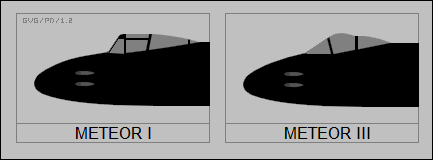
The pilots appreciated the additional power of the Meteor III over the Meteor I, as well as the improved view with the new canopy. However, the ailerons had been deliberately wired to be "heavy" to prevent aerobatic maneuvers from overstressing the wings, and pilots complained that flying the aircraft could be very tiring; that hadn't been a problem with the Meteor I, since it hadn't been cleared for aerobatic maneuvers. Pilots also complained that the machine tended to "snake" at high speed, limiting its accuracy as a gun platform, and it tended to become uncontrollable in a dive due to compressibility buffeting. However, the aircraft was basically liked. A flight combat exercise against the excellent Hawker Tempest V piston fighter concluded:
BEGIN_QUOTE:
The Meteor III is superior to the Tempest V in almost all departments. If it were not for the heaviness of its ailerons and the consequent poor maneuverability in the rolling plane, and the adverse effect of snaking on it as a gun platform, it would be a comparable all-round fighter with greatly increased performance.
END_QUOTE
A few Meteor IIIs flew to the Continent in January 1945, to operate out of the Low Countries with the 2nd Tactical Air Force until the end of the war in early May 1945. They performed ground strafing attacks, but never engaged in air combat. Meteor pilots were keen to test their aircraft against the Messerschmitt Me 262 jet fighter, but at least initially they had orders not to fly beyond enemy lines lest one of their aircraft be shot down and examined. As the war dragged on to its finale and German fuel supplies dried up, the Luftwaffe flew fewer and fewer sorties and opportunities for a jet-on-jet encounter faded out. The first jet dogfights would have to wait for the next war.
Some Meteors were painted white during the winter of 1944:1945 for camouflage, and also so that Allied anti-aircraft gunners wouldn't mistake them for German jets. Meteors were fired on anyway, but none were lost to "friendly fire" -- though there were losses in flight accidents, some fatal.
Just after the end of the war in Europe, a few Meteor IIIs were evaluated for possible use in the photo-reconnaissance role, but at the time their performance was not that superior to the Spitfire PR.XIX and the Meteor's range was definitely worse. The idea was not adopted, but it wasn't forgotten, either.
Following deck handling trials with a Meteor prototype in 1945, two Meteor IIIs were fitted with an arresting hook and reinforced landing gear, and used for carrier trials in 1948. The two aircraft performed takeoffs and landings from the carriers HMS ILLUSTRIOUS and HMS IMPLACABLE. The Royal Navy was impressed by the navalized Meteor, but decided to obtain the Supermarine Attacker instead.
BACK_TO_TOP* The Meteor III was a substantial improvement over the Meteor I, but the basic design still had not reached its full potential. Wind-tunnel and flight tests demonstrated that the short nacelles of the Meteor III, which ended just behind the wing, contributed heavily to compressibility buffeting at high speed, and a new, longer nacelle was designed as a fix. The new nacelles increased the redline speed at altitude by a startling 120 KPH (75 MPH), even without new powerplants. The last batch of Meteor IIIs that rolled off the production line featured the longer nacelles, and apparently some Meteor IIIs were retrofitted in the field with them as well.
Engine development had continued in the meantime, and one Meteor III was built with Rolls-Royce Derwent 5 engines, the scaled-down version of the Nene, providing 15.6 kN (1,590 kgp / 3,500 lbf) thrust each. This aircraft first flew in July 1945 and became the prototype of the next Meteor variant, the "F.4" (Fighter Mark 4, the RAF having switched from Roman to Arabic numerals by that time, the type having the company designation "G-41F").
However, in Britain the end of the war was followed by a general assumption that nobody was going to be in the mood for more fighting any time soon -- an idea that would prove a delusion -- and also by general physical and economic exhaustion. For the moment, there was no urgency to produce an updated Meteor variant. As a result, Gloster, under Air Ministry direction, continued to tweak the Meteor design without putting a new version into production. One F.4 prototype had its guns removed, gun ports faired over, and engines uprated for burst power to set a world speed record of 975 KPH (606 MPH) on 7 November 1945, with Group Captain H. Wilson at the controls.
On learning that the Americans were preparing for a counter-assault on the world speed record with the Lockheed Shooting Star, the RAF reworked a few F.4 prototypes with a number of tweaks, most notably clipping the wings to reduce the span by 1.47 meters (4 feet 10 inches), and broke the Meteor's own world speed record on 7 September 1946, with Group Captain "Teddy" Donaldson clocked at 991 KPH (616 MPH). The aircraft was painted yellow and named either "Forever Amber" or "Yellow Peril". It is an interesting comment on the rate of progress in aircraft performance at that time that this was regarded as such an astonishing improvement in performance that many believed aircraft wouldn't get much faster any time soon.
* The Meteor F.4 finally went into production in 1947. It featured the Derwent 5 engines and the clipped wings, a stronger airframe, a fully pressurized cockpit, lighter ailerons to improve maneuverability, and rudder trim adjustments to reduce snaking. The F.4 could also be fitted with a drop tank under each wing, and experiments were performed with carriage of underwing stores.
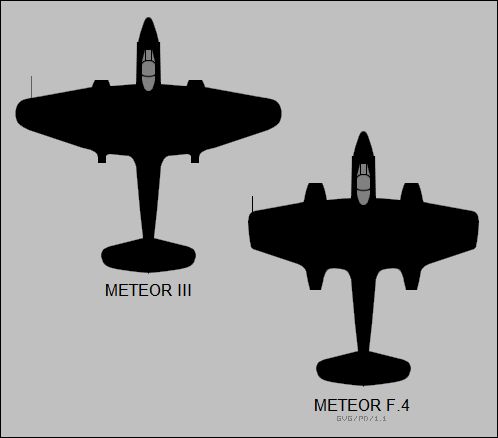
The clipped wings both provided greater speed and improved the roll rate, though at the expense of a longer takeoff run and faster landing speed. They were also intended to reduce stress on the wings, following an accident when a Meteor broke up in the air after pulling out of a dive, killing a Gloster test pilot.
A total of 535 Meteor F.4s was built for the RAF, with 48 of that number second-sourced by Armstrong-Whitworth. The F.4 was also exported in large numbers. Gloster took an F.4 on a sales tour in 1947, painted red with white detailing. Although this aircraft was damaged beyond repair by a Belgian pilot early in the tour due to a landing gear malfunction, international sales were brisk.
100 were bought by Argentina in 1947, with the aircraft sent to the country as kits, which were then assembled by Gloster personnel. They saw action during political unrest in 1955, with at least two being lost, and remained in service into the early 1970s. 48 were bought by Belgium, 20 by Denmark, 12 by Egypt, and 38 by the Netherlands. The Dutch later obtained 27 used F.4s from the RAF, and the French obtained a pair of used F.4s for development work, one being used to test Atar axial-flow turbojets.
___________________________________________________________________
GLOSTER METEOR F.4:
___________________________________________________________________
wingspan:
11.3 meters (37 feet 2 inches)
wing area:
32.51 sq_meters (350 sq_feet)
length:
12.5 meters (41 feet)
height:
3.96 meters (13 feet)
empty weight:
5,090 kilograms (11,220 pounds)
loaded weight:
6,600 kilograms (14,550 pounds)
maximum speed:
930 KPH (580 MPH / 505 KT)
service ceiling:
12,200 meters (40,000 feet)
range (no tanks):
980 kilometers (610 MI / 530 NMI)
___________________________________________________________________
As with the original Meteor prototypes, the Meteor F.4 was used as an engine test bed. Meteors were fitted axial-flow engines, including the MetroVic F.2/4 Beryl, the ancestor of the Armstrong-Siddeley Sapphire, and with Rolls-Royce RA.2 and RA.3 Avon engines. These engines were mounted in oversized nacelles, in much the same way as had the MetroVic F.2s tested with one of the original Meteor prototypes. Both the Beryl and Avon test aircraft demonstrated extraordinary rates of climb.
In 1954, one of these same Meteors received a highly unusual engine fit, consisting of Nene engines with thrust deflectors on the bottom of the engine nacelles, intended to lower takeoff and landing speed. This engine fit demanded extensive modifications to the aircraft, with nacelles extended forward of the wings, clipped wings replaced by the old full-span wings, and replacement of the F.4 tail structure with the revised and lengthened tail structure of the Meteor F.8, of which more is said below. Results were promising, but the scheme was regarded as too complicated. "Vectored thrust" systems would have to wait for a decade or so to become more respectable.
Other experimental engine fits included the French Atar engine, mentioned above, and afterburning versions of the Derwent Mark 5 and Mark 8. Meteor F.4s were also used to evaluate in-flight refueling schemes, which were never implemented in production Meteors, and Martin Baker ejection-seat trials, which led to standard fit of such seats in the later Meteor F.8.
* Over 90 F.4s were modified by Flight Refueling LTD beginning in 1954 as target drones. The conversions were given the designation of "Meteor U.15", and featured airframe reinforcement; jettisonable wingtip camera pods for scoring, with the pods recovered by parachute and containing a radio beacon for location; and an infrared flare system, with triple-flare launchers under each engine nacelle. They were radio-controlled, but still could be flown by a pilot. The cannon were of course removed. The U.15s served with both Britain and Australia. They were mostly used for missile trials and the like. They were too expensive to be considered particularly expendable.
* Several other Meteor variants were derived from the F.4. The experimental "FR.5" (Fighter-Reconnaissance Mark 5, or "G-41H") variant first flew on 13 July 1949. This aircraft featured two cameras in the rear fuselage for on-track imaging, and a single camera in the nose for oblique imaging. The nose camera could be repositioned by ground crews to shoot through one of three windows. Unfortunately, the first flight of the FR.5 was also its last: it broke up in the air during a low-level high-speed pass, killing the test pilot. However, the concept was not abandoned and would be revived later.
The "F.6 (G-41J)" never got off the drawing board. Some sources claim it was a swept-wing variant; others claim it incorporated features that would go into the F.8. However, the two-seat "T.7" (Trainer Mark 7, or "G-43") variant did go into production, and served usefully with the RAF and other air services for many years. It featured a tandem two-seat cockpit with an antique-appearing "greenhouse" or "frame" canopy. Since the Meteor was often the first jet operated by foreign air arms that purchased the type, orders often included a few T.7s for conversion training. 650 T.7s were built.
BACK_TO_TOP* As improved jet fighters began to emerge in the years following the war, Gloster decided to redesign the F.4 to keep it up to date, while retaining as much of the manufacturing tooling of the F.4 as possible. The result was the "Meteor F.8 (G-41K)". The first prototype was a modified F.4, followed by a true prototype that flew on 12 October 1948. Initial deliveries to the RAF were in August 1949.
The F.8 featured a fuselage stretch of 76 centimeters (30 inches), intended to shift the aircraft's center of gravity and eliminate the dead weight of ballast that had accumulated in earlier marks -- which had reached a total of about 450 kilograms (1,000 pounds) in the F.4. Evaluation of the stretched fuselage in the initial prototype gave positive results, except that the expenditure of ammunition gradually made the aircraft tail-heavy and unstable around the pitch axis. However, by an odd stroke of luck, Gloster had developed a single-engine jet fighter designated the "G.42" that hadn't entered production; its tail design ultimately featured the tailplane raised to the middle of the tailfin, and fitting the tail of the G.42 to the modified F.4 cleared up the pitch stability problem. Given the modular design of the Meteor, fitting the new tail proved simple. It also made the new variant distinctively different from its predecessors. While the tailfin of earlier Meteors was elliptical, resembling an asymmetric guitar pick, the new tailfin had straight edges.
Another important change in the F.8 was, of course, still further uprated powerplants, in the form of Derwent 8 engines with 16 kN (1,633 kgp / 3,600 lbf) thrust each. Other changes included structural strengthening, a Martin Baker ejection seat as evaluated earlier on the F.4, and a revised "blown" cockpit canopy that provided improved pilot visibility. The F.8 could carry two 450-kilogram (1,000-pound) bombs or sixteen rocket projectiles.
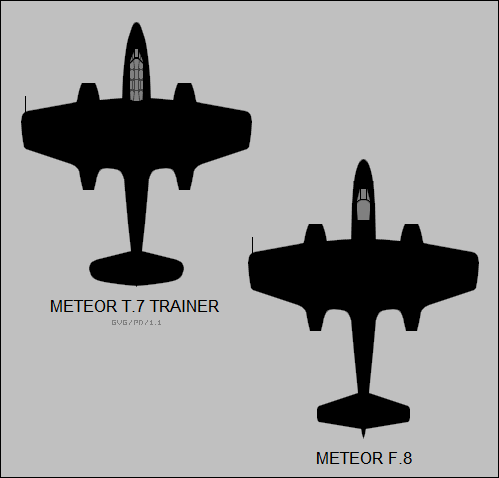
* The Meteor F.8 was the mainstay of RAF Fighter Command between 1950 and 1955, though it was increasingly outmatched by newer swept-wing fighters developed during this period, such as the US North American F-86 Sabre and the Soviet MiG-15. It was eventually replaced in RAF squadron service by the Hawker Hunter.
Although the Meteor may have been obsolescent in the 1950s, it served with distinction with the Royal Australian Air Force (RAAF) during the Korean War in the ground-attack role. The RAAF began receiving Meteor F.8s at the end of 1949, most of which were fitted with a radio compass, with the antenna in a small dome on the aircraft's spine. The RAAF received 93 ex-RAF Meteor F.8s for combat service in Korea from 1951 through 1953, plus nine T.7s for operational conversion.
The F.8 was used for escort duties at first, with the aircraft's initial combat mission taking place on 29 July. A month later the Meteors mixed it up with MiG-15s and got the worst of it, with one Meteor lost and the pilot taken prisoner, along with two other aircraft badly damaged. The Meteor seemed to be no match for the MiG-15, though Australian pilots protested that they might have done much better had they been trained for air-to-air combat instead of ground support. Their protests went unheeded; by the end of 1951, the Meteor had been relegated to the ground-support role.
That was dangerous work, all the more so because a Meteor had to be held smooth and level on its firing run for its gyro-stabilized gunsight to be accurate, making the aircraft vulnerable to ground fire. 32 were lost in action. Despite the aircraft's general inferiority to the MiG-15, the Australians were able to score at least three "kills" against the Soviet fighter with the Meteor, with Flight Sergeant George Hale claiming two of the kills in his F.8, named "Halestorm". After the war, the F.8s were sent home to Australia, to be replaced by Commonwealth CA-27 Sabres in the mid-1950s.
* A total of 1,183 F.8s was built in all by Gloster and Armstrong-Whitworth, with 23 ex-RAF aircraft supplied to Belgium, 60 new-build aircraft to Brazil, 20 new-build aircraft to Denmark, 12 ex-RAF aircraft to Egypt, 11 new-build aircraft to Israel, 5 ex-RAF aircraft to the Netherlands, and 12 new-build and 7 ex-RAF aircraft to Syria.
Fokker built 150 F.8s for the Dutch and 150 F.8s for the Belgians. Avions Fairey built 30 from kits supplied by Fokker and 37 from kits supplied by Gloster, with these aircraft going into Dutch service.
___________________________________________________________________
GLOSTER METEOR F.8:
___________________________________________________________________
wingspan:
11.3 meters (37 feet 2 inches)
wing area:
32.51 sq_meters (350 sq_feet)
length:
13.6 meters (44 feet 7 inches)
height:
3.96 meters (13 feet)
empty weight:
4,850 kilograms (10,680 pounds)
loaded weight:
7,120 kilograms (15,700 pounds)
maximum speed:
960 KPH (600 MPH / 525 KT)
service ceiling:
13,100 meters (43,000 feet)
range:
965 kilometers (600 MI / 525 NMI)
___________________________________________________________________
* Two reconnaissance variants of the F.8 were also built. The "FR.9" (Fighter Reconnaissance 9, or "G-41L") retained the four 20-millimeter Hispano cannon, but had an extended nose to accommodate a camera that could be oriented on the ground to shoot through one of three windows. It could also carry an external tank under each wing and an external tank under the belly.
A total of 126 FR.9s was built and went into RAF service in the low-level reconnaissance role, with 12 of these aircraft later passed on to Ecuador, 7 passed on to Israel, and two passed on to Syria. RAF Meteor PR.9s saw extensive use in the 1956 Suez intervention, and Middle Eastern Meteors of various types saw intermittent combat through the 1950s.
The "PR.10 (G-41M)" was intended for the high-altitude reconnaissance role. It not only had the older long-span wing, it also had the older elliptical Meteor F.4 tail. Armament was deleted, and it was fitted both with a camera in the nose as with the FR.9 and with two cameras in the rear fuselage for along-track imaging. The RAF received 59 PR.10s. None were exported.

The RAF also operated reconnaissance Meteors during security operations in Kenya, Aden, Cyprus, and Malaya through the 1950s.
* The F.8 proved popular as a test and trials aircraft. F.8s were used to test airborne radar for the Fireflash missile, midair refueling schemes, and engine fits. A heavily modified F.8 experimentally fitted with Armstrong-Siddeley Sapphire 2 engines set a world climb-rate record in August 1951. One test rig was fitted with the Armstrong-Siddeley Screamer rocket engine, fitted under the fuselage. Another was fitted with Rolls-Royce Soar mini-jet engines on the wingtips, while retaining its Derwents, making it the only four-engine Meteor.
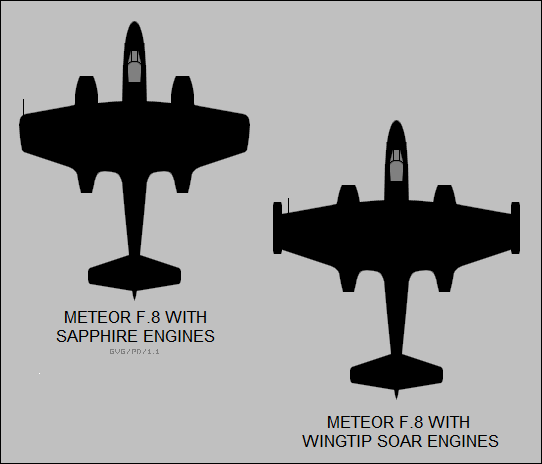
One of the oddest test fits was put together by Armstrong-Whitworth, and involved adding a second cockpit to a longer nose. This additional cockpit was intended to accommodate a pilot lying in a prone position on his stomach, in the belief that this posture might provide greater tolerance to gee forces. This testbed was first flown in February 1954, but the idea didn't pan out: rear view and escape were troublesome, while improved gee suits could deal with the gee force issue. Reclined seats would ultimately prove a better solution.
Martin Baker obtained three odd hybrids of T.7s with F.8 tails for ejection seat trials. They were informally given the designation "Meteor T.7 1/2". They provided many decades of fine and reliable service for Martin Baker. As of 2017, two of them are still in service,

Gloster also modified an F.8 into a specialized close-support configuration, with wingtip tanks and belly stores pylons. This aircraft was known as the "Reaper" or "G.44", and could carry 24 rockets or up to four 450-kilogram (1,000-pound) bombs.
One FR.9 was modified in 1955 to test the Rolls-Bristol RB.108 lift engine, a stubby turbojet designed to be fitted vertically into an aircraft to provide additional lift for short takeoffs and landings. The FR.9 was modified with a single RB.108 in the fuselage; the fit was intended strictly for engine test purposes and the configuration was never considered for operational service.
* A small number of F.8s were converted to a simple target tug configuration and redesignated "Meteor F(TT).8". The only modification was fit of a target towing lug under the fuselage, allowing the aircraft to pull a target banner. A number of T.7s and F.8s in foreign service were also used as target tugs in this fashion. In addition, some F.8s were put into service as advanced single-seat trainers, apparently with some small modifications, and designated unofficially as "Meteor T.8".
Following the use of Meteor F.4s converted to the U.15 target drone configuration, about 250 Meteor F.8s were converted to "U.16" target drones by Flight Refueling LTD, beginning in 1956. The last conversion was apparently in 1975. The Australians received similar conversions with some minor differences in equipment kit as the "U.21".
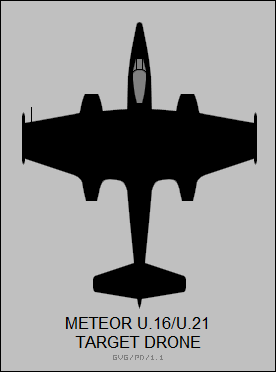
The U.16 / U.21 conversion was broadly similar to the U.15 conversion, with airframe reinforcement, wingtip camera pods, radio control (with optional piloted capability), and no cannons. However, the U.16 had a characteristic modified extended nose, the camera pods were slenderer, and it is unclear if it had flare dispensers. These machines remained in service to the end of the century.
BACK_TO_TOP* In January 1947, the Air Ministry issued the specification F.44/46 for a two-seat, twin-jet-engine, night / all-weather fighter to replace the de Havilland Mosquito. A number of companies responded to the request, but none of their proposals met the requirement. Since there was still a need for a night fighter, Gloster suggested stretching the T.7 by 1.5 meters (five feet) to accommodate airborne intercept (AI) radar in the nose. This machine was intended as an interim solution until the Gloster Javelin, then in development, was ready for service.
The proposal was accepted under the specification "F.24/48", but Gloster, having brought up the suggestion, was forced to admit that the company didn't have the resources to produce the machine. However, Armstrong-Whitworth, another member of the Hawker-Siddeley industrial group along with Gloster, had second-sourced the Meteor, and in 1949 Armstrong-Whitworth was given ownership of the project.
The first Meteor "NF.11" (Night Fighter Mark 11) or "G/47" prototype, a modified T.7, began flight tests in October 1949. The first true NF.11 prototype flew on 31 May 1950. The NF.11 retained the Derwent 8 engines of the F.8, but the four cannon were transferred from the nose to the wings, the wings were lengthened back to the original Meteor I span, and the longer nose accommodated AI.10 (US SCR-720) radar, plus a pressurized tandem cockpit. The cockpit featured a T.7 greenhouse canopy and a radar operator / navigator in the back seat.
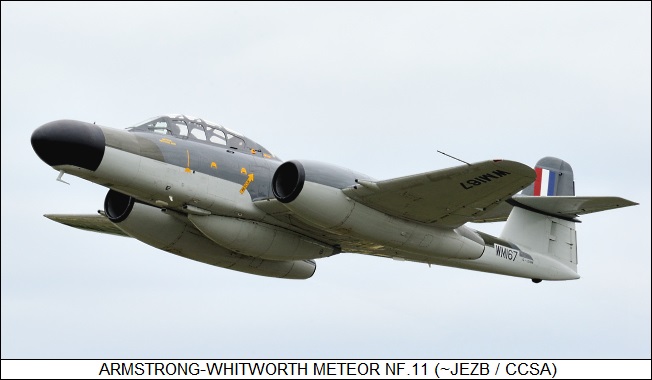
The first production NF.11, with a proper Meteor F.8 tail, flew on 13 November 1950, and 307 production NF.11s were built. The Danes bought 11; the Belgians obtained 24 ex-RAF aircraft; somewhat surprisingly the French bought 41 used RAF NF.11s; and a single example was sent to Australia, presumably for evaluation.
* The NF.11 was followed by the "NF.13" and "NF.12", in that order, with the reversal of the numeric sequence apparently due to the fact that though the NF.13 revision was started later than the NF.12, being a more modest upgrade it was completed sooner. All the Meteor night fighter variants retained the "G.47" company designation.
In fact, the NF.13 was largely identical to the NF.11, except that it had a radio compass, cockpit cooling ducts, and other changes for tropical operation, plus larger intakes to improve air mass flow to the engines, resulting in 440 kN (45 kgp / 100 lbf) more thrust. The first NF.13 flew on 23 December 1952, and 40 were built.
The NF.12 featured Derwent 9 engines with 16.9 kN (1,725 kgp / 3,800 lbf) thrust each, and the nose lengthened by 43 centimeters (17 inches) to accommodate improved American Westinghouse AN/APS-21 radar. The top half of the tailfin was enlarged to compensate for the longer nose, giving the tailfin a slightly crooked appearance. The first NF.12 flew on 21 April 1953, with 100 being built. France obtained two for test purposes, and six each ex-RAF aircraft were provided to Egypt, Syria, and Israel.
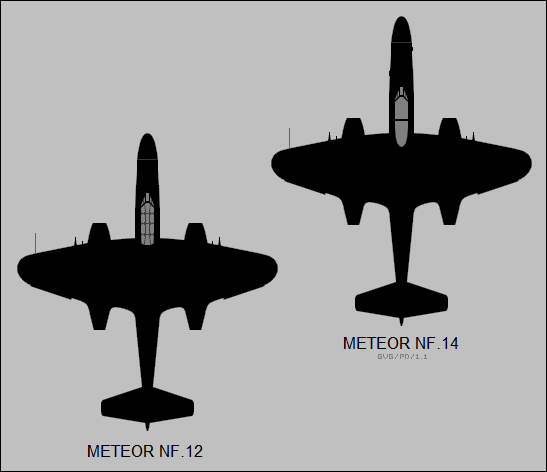
* The "NF.14" was generally similar to the NF.12, but featured a "blown" clear-vision canopy to provide a much better view than the old framed canopy; improved US AN/APQ-43 radar and an even longer nose; yaw dampers to control "snaking"; and other lesser changes. 100 NF.14s were manufactured and were the final Meteors built, with the very last of the breed delivered on 26 May 1955. The Meteor night fighters remained in front-line RAF service until 1961. The total number of Meteor night-fighters built by Armstrong-Whitworth was 547.
___________________________________________________________________
ARMSTRONG-WHITWORTH METEOR NF.14:
___________________________________________________________________
wingspan:
13.1 meters (43 feet)
wing area:
34.74 sq_meters (374 sq_feet)
length:
15.5 meters (51 feet 4 inches)
height:
4.2 meters (13 feet 11 inches)
empty weight:
5,725 kilograms (12,620 pounds)
max loaded weight:
9,625 kilograms (21,200 pounds)
maximum speed:
587 KPH (930 MPH / 810 KT)
service ceiling:
12,200 meters (40,000 feet)
range:
1,530 kilometers (950 MI / 825 NMI)
___________________________________________________________________
Some of the NF.14s were later converted to "NF(T).14" navigation trainers. Others were modified as target tugs, with a windmill-powered winch mounted inboard of the right engine, and were designated "TT.20". The TT.20s remained in service with the RAF at least into the 1970s.
* A total of 3,924 Meteors was built in all, and the type served with ten air forces. The following list gives Meteor variants and their production quantities:
* Gloster's single-engine jet fighter, the G.42, is worthwhile to discuss briefly here since its design, or at least the design of its tail, contributed to the development of the Meteor F.8 and later Meteor marks.
The G.42 was a direct evolution of the G.40 Gloster Whittle, with various configurations being considered from early 1942. After some false starts, Air Ministry E.1/44 specification was issued in early 1944, and Gloster was selected to build four prototypes of the "Ace", as it was informally known. With the slowdown in aviation work after the end of the war, the first prototype wasn't completed until July 1947. That aircraft never flew, since it was involved in a traffic accident while being road-transported and was written off -- an embarrassing end, it was probably a good thing that a machine with such extraordinary bad luck never got off the ground.
The second prototype was completed and first flew on 9 March 1948. It was of undistinguished appearance, of all-metal construction, a straight mid-mounted wing, engine inlets on the fuselage just in front of the wings, and tricycle landing gear. It was to operate as a fighter-bomber, armed with four Hispano 20-millimeter cannon under the nose, with the capability of carrying a 450-kilogram (1,000-pound) bomb under each wing, or a total of eight rockets.
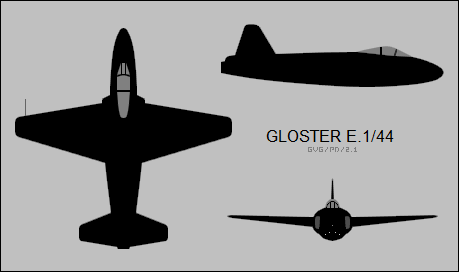
It was powered by a single Rolls-Royce Nene turbojet with 22.3 kN (2,270 kgp / 6,000 lbf) thrust. Wingspan was 11 meters (36 feet), length was 11.6 meters (38 feet), empty weight was 3.750 kilograms (8,260 pounds), and loaded weight was 5,200 kilograms (11,470 pounds).
A third prototype, with a modified tail featuring the raised tailplane mentioned earlier, was built and flew in 1949, and a swept-wing version was considered under Air Ministry specification E.23/46 -- but by then, it was obvious the E.1/44 was behind the times, and the fourth prototype was never built. The only legacy of the E.1/44 was its tail, which survived in the Meteor F.8.
BACK_TO_TOP* The Meteor is noteworthy for its historical significance as the first Allied jet fighter to see service, as well as for its long service with the RAF and many other countries. To be sure, it was obsolete by the 1950s and only remained in production and service while nothing better was available, but this was no fault of the design itself. It was a first-generation jet that continued to serve well into the era of second-generation jets that built on its experience. The Meteor itself still remained simple, clean, and appealing, as were many of the first-generation jets. Meteors continued to fly into the 21st century as targets or trials machines, and a few still take to the sky at airshows. A large number survive on static display, particularly as "gate guards" at air bases.
* I got to tinkering with a UK penpal on a "what if" concept, working on the basis that somebody got a hot deal on a batch of Meteor airframes that had plenty of service life left on them, and decided to update them to a modern light strike configuration -- which I dubbed the "Meteor 2020".
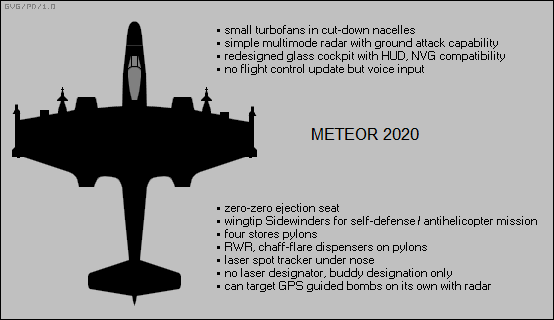
The basic assumptions were no basic airframe changes; retain the manual flight controls; and use of readily available off-the-shelf kit, such as a low-cost multimode radar with ground attack options, a standard glass cockpit scheme with voice input & output, GPS navigation, zero-zero ejection seats, and so on. Engines would have to be modernized, I was thinking a PW545 turbofan would fit and do the job -- but if not, the little GE J85 turbojet would work. Having "designed" the Meteor 2020, it's interesting to wonder how practical it would be -- maybe somebody might want to build airshow replicas, like the Me-262 replicas, and sell some for combat service as well.
* Sources include:
* Revision history:
v1.0 / 01 oct 00 v1.1.0 / 01 dec 02 / Review & polish. v1.1.1 / 01 dec 04 / Review & polish. v1.1.2 / 01 nov 06 / Review & polish. v1.1.3 / 01 nov 08 / Review & polish. v1.1.4 / 01 oct 10 / Review & polish. v1.2.0 / 01 apr 12 / Added Meteor 2020. v1.2.1 / 01 mar 14 / Review & polish. v1.2.2 / 01 oct 14 / Review & polish. v1.2.3 / 01 sep 16 / Review & polish. v1.2.4 / 01 aug 18 / Review & polish. v1.2.5 / 01 jun 20 / Review & polish. v1.2.6 / 01 apr 22 / Review & polish. v1.2.7 / 01 mar 24 / Review & polish.BACK_TO_TOP
